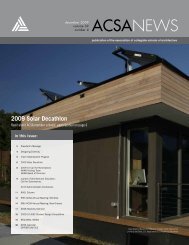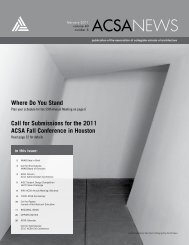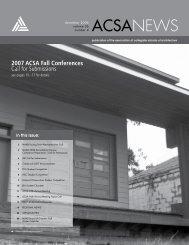digital aptitudes - Association of Collegiate Schools of Architecture
digital aptitudes - Association of Collegiate Schools of Architecture
digital aptitudes - Association of Collegiate Schools of Architecture
You also want an ePaper? Increase the reach of your titles
YUMPU automatically turns print PDFs into web optimized ePapers that Google loves.
FRIDAY, MARCH 2, 2012 - 2:00PM - 3:30PM<br />
Beyond Digital: Speculations on Analog Convergence<br />
Brian Lonsway, Syracuse University<br />
From Digital Materials To Self-Assembly<br />
Skylar Tibbits, Massachusetts Institute <strong>of</strong> Technology<br />
A new paradigm is upon us, one that challenges our notions <strong>of</strong> assembly<br />
by looking to transfer <strong>digital</strong> and computational information<br />
from our design s<strong>of</strong>tware and machine control through our physical<br />
methodologies <strong>of</strong> construction. The construction industry has<br />
traditionally been plagued by analogue processes inherited from<br />
the industrial revolution where raw materials are sent through machines<br />
and assembly sequences fighting tolerance, machine errors<br />
and efficiency. On the contrary, information can now flow through<br />
materials and embody adaptability and material computation, <strong>of</strong>fering<br />
a new vision for construction where materials literally build<br />
themselves. This is a new paradigm for designing and making, one<br />
that <strong>of</strong>fers the ability for self-assembling, self-repairing and replicating<br />
structures. This vision challenges our notions <strong>of</strong> the <strong>digital</strong>,<br />
converting analogue processes into <strong>digital</strong> information transfer by<br />
“computing-through-construction” and pointing towards new opportunities<br />
for manufacturing, construction and design tools.<br />
Parallel Tracks: Digital | Analog Dialogue in Toy<br />
Development<br />
Jennifer Akerman, University <strong>of</strong> Tennessee-Knoxville<br />
Designers and fabricators have long understood their work to<br />
be related, but distinct. Boundaries, some intuited, others legally<br />
proscribed, dictate that designers establish the intent for a given<br />
outcome, while fabricators generate the actual work or product.<br />
That understanding is an action-based view, focusing on tasks performed<br />
by specific people or entities. We could shift our consideration<br />
towards the nature <strong>of</strong> work itself and state that there have<br />
traditionally been two fields, interrelated but distinct: design and<br />
craft. How are we to understand the changes to both <strong>of</strong> these fields<br />
necessitated by the ways emerging methods, practices, and technologies<br />
are merging the two? This essay will discuss the <strong>digital</strong><br />
| analog convergence in design and fabrication as illustrated by<br />
examples from a line <strong>of</strong> toys developed through the collaboration<br />
<strong>of</strong> an architect and mechanical engineer. Our work considers questions<br />
<strong>of</strong> craft and fabrication, relying extensively on both <strong>digital</strong> and<br />
tangible techniques in continual iterative dialogue. Also at hand is<br />
a parallel consideration <strong>of</strong> the <strong>digital</strong> | analog convergence in the<br />
realm <strong>of</strong> toy design, considering toys as objects designed for interaction<br />
and play. Our continued engagement in the convergence<br />
<strong>of</strong> technology, material, and culture in the interest <strong>of</strong> design and<br />
fabrication is a catalyst for speculations <strong>of</strong> what may come next.<br />
Émission<br />
Jordan Geiger, SUNY at Buffalo<br />
More than its physical matter, architecture’s conditions - its determinants,<br />
performance, milieu, and multiple stakeholders - grow<br />
ever more ethereal. The “ether” condition can be named as such<br />
because <strong>of</strong> its entropic, expanding and hazy mixture <strong>of</strong> physical<br />
and computational and other characteristics; and possibly for a resulting<br />
delirium in its movement past any paradigm in which any<br />
<strong>of</strong> these parameters can lay dominant claim to its formation. Answering<br />
to an ever-expanding set <strong>of</strong> contemporary exigencies from<br />
market crashes and shifting climates to globalized sources <strong>of</strong> building<br />
materials and the evolving influence <strong>of</strong> ubiquitous computing,<br />
the built environment provokes speculation on its possible futures<br />
that must lie far outside <strong>of</strong> typological or even scalar parameters. It<br />
needs critical fictions as a means for planning tactically past choices<br />
<strong>of</strong> utopic or dystopic scenarios, embracing instead a messy tangle<br />
<strong>of</strong> new and future influences and a sober acceptance that analog<br />
convergence recasts architects more like steampunk novelists or<br />
design noir authors (to borrow here a term from Anthony Dunne).<br />
These influences resemble the categories found in a building code<br />
or current teaching curriculum, but in name only: cultural, technological,<br />
legal, material, to name a few. Upon further examination,<br />
the nature <strong>of</strong> each has already so fundamentally transformed as to<br />
demand speculation far past existing models <strong>of</strong> architect-consultant<br />
relationships or any mere new upskilling for young designers.<br />
We need new methods now to participate in speculating on the<br />
built environment’s future.<br />
A Materiality <strong>of</strong> Agency//Speculations on the Impact <strong>of</strong><br />
Biological Computation on Materiality and Space<br />
Nicole Koltick, Drexel University<br />
Architects have traditionally viewed space as a static entity that is<br />
defined, shaped, and enhanced through the use <strong>of</strong> material objects<br />
that give form, structure and order to our daily existence. There<br />
have been clear boundaries between inside and outside, delineation<br />
between distinct building materials, the program and the<br />
project. But looking forward, is it possible that human interactions<br />
with objects and environments might be drastically re-envisioned,<br />
encompassing a more malleable and adaptive view <strong>of</strong> space and<br />
materiality? In this paper, I will explore how potential human interactions<br />
with space, objects and information may be transformed<br />
in the future through analyzing recent developments in biological<br />
computing, synthetic biology and object-oriented philosophy. To<br />
start, I propose an expanded definition <strong>of</strong> agency with respect to<br />
materials and objects. How can we begin to formulate conceptions<br />
<strong>of</strong> agency as they relate to objects or new categories such as<br />
object-beings1? Recent writings from object oriented philosophers<br />
may <strong>of</strong>fer a way forward through a novel reframing <strong>of</strong> the conventional<br />
pattern <strong>of</strong> interactions between humanity, materials and<br />
environments. Object oriented ontology allows for a total reconsideration<br />
<strong>of</strong> the relationships between ourselves, object-beings, and<br />
object-object associations. Humans are highly complex “machines”<br />
Digital Apptitutes + Other Openings - Boston, MA - 19








